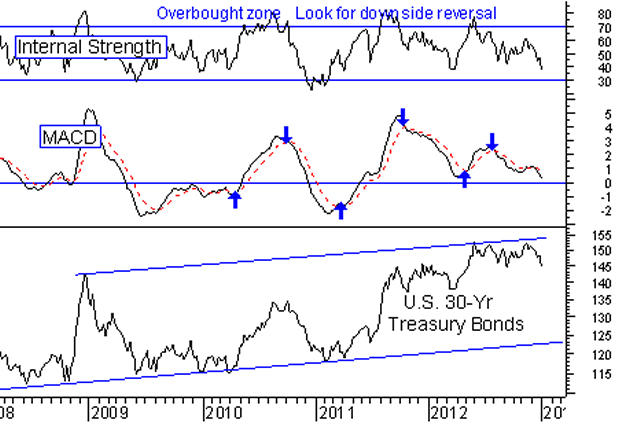Over Due U.S. Treasury Bond Sell-off To Become More Serious!
Interest-Rates / US Bonds Jan 05, 2013 - 07:54 AM GMTBy: Sy_Harding
 With my indicators on a sell signal for bonds since August 16, I have been warning about bonds being overbought and in danger of rolling over into a serious correction for several months. And indeed, the 20-year U.S. Treasury bond has already lost 11% of its value just since its late July peak.
With my indicators on a sell signal for bonds since August 16, I have been warning about bonds being overbought and in danger of rolling over into a serious correction for several months. And indeed, the 20-year U.S. Treasury bond has already lost 11% of its value just since its late July peak.
Yet Treasury bonds are still significantly over-extended above the prices that prevailed most of the time before, during, and after the 2008 financial crisis, except for two previous brief spike-ups, in 2008, and 2010 (and those ended with substantial plunges back to normal).

And now another problem for bonds has popped up.
As we all know, the Treasury Department, and both the Bush and Obama administrations battled the awful economic collapse of 2008 from the fiscal side, with greatly increased government spending, and massive stimulus and bail-out programs.
From the monetary side, the Federal Reserve used its normal stimulus tool of cutting interest rates, and when even drastic cuts had no impact, it launched what it admitted was an untried experiment, so-called quantitative easing, in an effort to do its part in helping to lift the economy out of the worst recession in 80 years.
That experiment, the Fed’s massive buying of paper assets, mostly U.S. Treasury bonds, was aimed at driving interest rates and bond yields down further - to promote borrowing and spending in the private sector to parallel the stimulative buying and spending by government.
When the first such program expired with the economy still only in a tepid recovery, additional QE programs followed; dubbed QE2, ‘Operation Twist’, and QE3 (which was just announced last month).
The Fed’s current balance sheet was released this week. It shows that as a result of those QE programs the Fed is now holding $1.66 trillion in U.S. Treasury bonds, and $926.7 billion in mortgage-backed securities. But it had pledged to continue the program through 2013 (or until the economy improves enough to have the unemployment rate down to 6.5%). At the current rate of purchases, that would mean the purchase of an additional $1.02 trillion of Treasury bonds this year.
The need for this degree of asset purchases was not envisioned in the beginning. Yet even with the earlier totals, many economists wondered how the second half of the grand experiment would eventually be worked out. That is, how would the Fed manage to eventually reverse its efforts and sell those assets off its balance sheet without driving interest and bond yields sharply higher, bond prices sharply lower, thus hurting the economy and bond investors?
It hadn’t seemed to be of immediate concern – until the Fed released the minutes of its last FOMC meeting this week.
Those minutes reveal that several FOMC committee members think that with the economic recovery showing increasing strength, the Fed will need to halt the bond purchases well before the end of 2013.
That moves up the timetable of worry about how the Fed would subsequently be able to take the next step of selling off the bonds it already owns.
And with that worry, another problem has risen for bonds.
As I have been warning, someone is beating the Fed to the bond exit door. The selling has the 20-year bond already down 11% since July. And now the Fed’s release of its FOMC meeting minutes this week is likely to put more pressure on bond-traders and large institutional holders to bail out of bonds even faster in order to stay ahead of further selling pressure that might result from the Fed halting its supportive bond-buying earlier than previously thought.
Look out below for bonds?
In the interest of full disclosure, I and my subscribers have a 20% position in the ProShares Short 20-year bond etf, symbol TLT.
Sy Harding was just named by Timer Digest as #1 Gold Timer for 2012 (Gold Timer of the Year), and #2 Long-Term Stock Market Timer for 2012.
Sy Harding is president of Asset Management Research Corp., and editor of the free market blog Street Smart Post.
© 2012 Copyright Sy Harding- All Rights Reserved
Disclaimer: The above is a matter of opinion provided for general information purposes only and is not intended as investment advice. Information and analysis above are derived from sources and utilising methods believed to be reliable, but we cannot accept responsibility for any losses you may incur as a result of this analysis. Individuals should consult with their personal financial advisors.
Sy Harding Archive |
© 2005-2022 http://www.MarketOracle.co.uk - The Market Oracle is a FREE Daily Financial Markets Analysis & Forecasting online publication.



